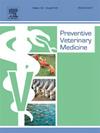The use of data for health and welfare management of farmed salmons in Norway, Scotland, and Ireland
IF 2.2
2区 农林科学
Q1 VETERINARY SCIENCES
引用次数: 0
Abstract
Data-driven solutions can support stakeholders’ decision-making when managing health and welfare in Atlantic salmon production. While many different types of data are being collected, knowledge about stakeholders’ use and needs regarding this data and data tools in their day-to-day work is limited. The current study explores the status quo of using data and data tools in salmon health management and needs of the stakeholders. Fourteen focus group discussions and three in-depth interviews were completed and analysed in Norway, Scotland and Ireland with salmon production managers, health experts and health inspectors from government and certification bodies (N = 44). Results showed that the participants valued the role that reliable data can play in salmon health management. Factors that influence data utilisation for decision-making were identified using the data lifecycle concept (i.e., the flow from collection to analysis and sharing). Generally, stakeholders preferred timely, ideally automatically recorded, standardised and high-quality data and wished for a tool that offers convenient access to data and facilitates data search and compilation. Furthermore, the comfort with which stakeholders use data tools varied, ranging from some stakeholders welcoming support from decision support tools to others preferring to rely mostly on their personal experience when analysing data. While some data sharing is mandatory (e.g., reporting of mortality from industry to authorities), the participants reported other forms of data sharing (e.g., informal exchange of information, not data, across companies). Lack of contextual factors contributes to a hesitancy to share data (e.g., lack of perceived benefits and fear over potential misuse). In Norway, stakeholders were more open to share data between the salmon industry and authorities. Being used to reporting more data, combined with operating in a larger industry where individual farms are not easy to single out from aggregated statistics, may have contributed to gaining trust among participants in Norway. However, in all three countries, some participants were reluctant to share data with the public or tied it to preconditions (e.g., ensuring it was presented in the right context, with explanations on the background for mortality), while others highlighted positive effects of sharing data, such as benchmarking and increased focus on preventive measures. Addressing barriers to data and data tool utilisation provides valuable insights that could benefit salmon health management and sustainability of the sector.
在挪威、苏格兰和爱尔兰使用数据进行养殖鲑鱼的健康和福利管理
数据驱动的解决方案可以支持利益相关者在管理大西洋鲑鱼生产中的健康和福利时做出决策。虽然正在收集许多不同类型的数据,但有关利益相关者在日常工作中对这些数据和数据工具的使用和需求的知识有限。本研究探讨了在鲑鱼健康管理中使用数据和数据工具的现状以及利益相关者的需求。在挪威、苏格兰和爱尔兰完成了14次焦点小组讨论和3次深入访谈,并对来自政府和认证机构的鲑鱼生产管理人员、卫生专家和卫生检查员进行了分析(N = 44)。结果表明,参与者重视可靠数据在鲑鱼健康管理中的作用。利用数据生命周期概念(即从收集到分析和共享的流程)确定了影响数据利用决策的因素。一般来说,利益相关者更喜欢及时、最好是自动记录、标准化和高质量的数据,并希望有一种工具可以方便地访问数据并促进数据搜索和汇编。此外,利益相关者使用数据工具的舒适度各不相同,一些利益相关者欢迎决策支持工具的支持,而另一些利益相关者在分析数据时更倾向于主要依靠他们的个人经验。虽然有些数据共享是强制性的(例如,行业向主管部门报告死亡率),但与会者报告了其他形式的数据共享(例如,公司间非正式的信息交换,而不是数据交换)。缺乏上下文因素导致对共享数据犹豫不决(例如,缺乏感知到的好处和对潜在滥用的恐惧)。在挪威,利益相关者更愿意在鲑鱼行业和当局之间共享数据。习惯于报告更多的数据,再加上在一个更大的行业中运营,单个农场不容易从汇总的统计数据中挑出来,这可能有助于获得挪威参与者的信任。然而,在所有三个国家中,一些与会者不愿与公众分享数据,或将其与先决条件联系起来(例如,确保在正确的背景下提供数据,并解释死亡率的背景),而另一些与会者则强调了共享数据的积极影响,例如制定基准和更加重视预防措施。解决数据和数据工具利用方面的障碍提供了有价值的见解,有助于鲑鱼健康管理和该部门的可持续性。
本文章由计算机程序翻译,如有差异,请以英文原文为准。
求助全文
约1分钟内获得全文
求助全文
来源期刊

Preventive veterinary medicine
农林科学-兽医学
CiteScore
5.60
自引率
7.70%
发文量
184
审稿时长
3 months
期刊介绍:
Preventive Veterinary Medicine is one of the leading international resources for scientific reports on animal health programs and preventive veterinary medicine. The journal follows the guidelines for standardizing and strengthening the reporting of biomedical research which are available from the CONSORT, MOOSE, PRISMA, REFLECT, STARD, and STROBE statements. The journal focuses on:
Epidemiology of health events relevant to domestic and wild animals;
Economic impacts of epidemic and endemic animal and zoonotic diseases;
Latest methods and approaches in veterinary epidemiology;
Disease and infection control or eradication measures;
The "One Health" concept and the relationships between veterinary medicine, human health, animal-production systems, and the environment;
Development of new techniques in surveillance systems and diagnosis;
Evaluation and control of diseases in animal populations.
 求助内容:
求助内容: 应助结果提醒方式:
应助结果提醒方式:


